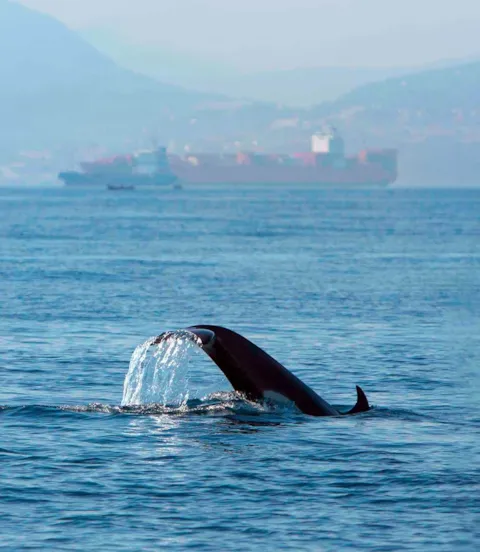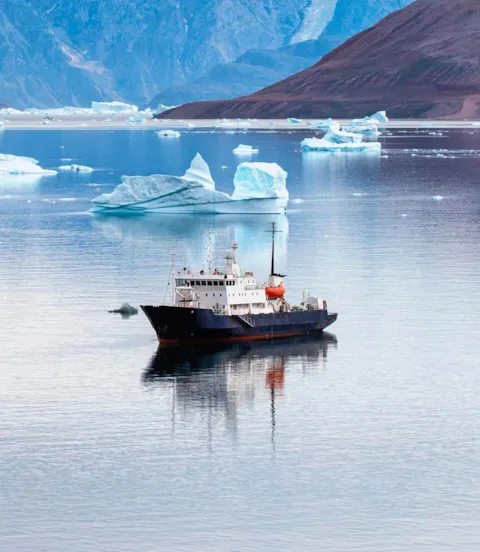Controlling underwater noise
Reduced environmental footprint, improved profit and better data quality are just some of the benefits of controlling unwanted underwater noise. SILENT class notations from DNV GL are designed to address growing levels of noise from human operations at sea, to the benefit of operators and marine wildlife alike.
The legendary oceanographer Jacques Cousteau was famous for saying that the sea is a silent world, but as he well knew, the sea is full of sounds that marine life depend on for their survival. Fish and marine mammals such as whales and dolphins rely on sound to communicate with each other, locate prey and navigate over long distances.
These and other vital activities are disrupted by noise from ocean-going ships, sonar devices and offshore energy operations. Sound travels nearly five times faster in water than in air, allowing it to penetrate large areas in just seconds. Scientists have become increasingly aware of this threat to biodiversity, and some rate underwater noise pollution as the next global threat after climate change and chemical pollution.
Not only fish and sea mammals, but many human marine enterprises are also negatively impacted by water-borne noise, including fisheries, research, emergency response and offshore activities where noise disturbs communication with subsea equipment. Underwater noise may reduce data quality and decrease the operational range and accuracy of underwater sensors such as echo sounders, positioning and communication systems, or towed arrays.

The first SILENT class notation
To address these marine noise-related issues, DNV GL issued the world’s first underwater noise notation in 2010, the SILENT class. The intention of the notation is to provide owners of acoustically sensitive vessels with concise and realistic criteria for underwater noise emission, and to provide environmentally conscious owners with an opportunity to demonstrate a low environmental footprint.
“Noise levels in the ocean are steadily increasing,” says DNV GL’s Head of Section, Noise and Vibration, Stian Andreassen. “Offshore activities are on the rise, and the noisiest ten per cent of the global fleet is thought to generate 90 per cent of ocean noise, so there is a clear target group for noise-reduction measures.”

The cost of underwater noise
“We had a case where a herring boat owner came to us and said he believed his boat was scaring the fish away,” Andreassen recalls. “We collected data while the boat was operating at sea and identified the noise source. The solution was a new propeller with a lower noise profile for herring. We have knowledge of hearing curves for different fish types, and we can adjust building and operational standards accordingly.” He notes that noise and vibration control can in many cases be integrated into vessel design without increasing building costs significantly.
Other vessel types, in particular cruise ships, may need to demonstrate a controlled noise emission when sailing in environmentally sensitive areas. Today the class notation SILENT provides rules for specific operations or vessel types, including Fishing, Seismic, Research, Acoustic and Environmental, defining acceptable noise for each category.


SILENT-R: For vessels requiring extremely low underwater noise radiation
The strictest level of underwater radiated noise requirement in the SILENT class notation is SILENT-R, or Research notation. In May 2019, DNV GL awarded SILENT-R to the DONG FANG HONG 3 scientific research vessel built by Jiangnan Shipbuilding (Group) Co., Ltd. (JN) for the Ocean University of China (OUC), a milestone for research vessels reached in China.
To ensure optimal performance of precision instruments, as well as the acquisition of accurate and reliable scientific research data, underwater radiated noise must be strictly controlled. In order to meet this challenge, attention to mitigation of underwater noise levels is required throughout design and construction of scientific research vessels.
To achieve this goal, DNV GL’s Maritime Advisory teams in Høvik and Shanghai, together with the OUC, Jiangnan shipyard, The Marine Design and Research Institute of China (MARIC), Shanghai Marine Diesel Engine Research Institute (SMDERI) and selected equipment manufacturers cooperated closely to control every detail of underwater noise radiation from design to construction and through to delivery. The final measurements showed underwater noise levels for DONG FANG HONG 3 to be compliant with DNV GL’s SILENT-R class notation for free-sailing conditions up to and including 11 knots, across the entire frequency band.

A full range of SILENT notations
SILENT class notation from DNV GL is increasingly recognized and applied globally by shipyards, owners and design institutes. At present, the notation has been adopted as underwater noise control criteria in numerous other research and naval vessel projects in the planning and construction phases worldwide. While SILENT-R notation focuses on noise issues that impact research vessels, the other noise class notations address the specific challenges in various areas of operation:
SILENT-E (Environmental) class notation
Applies to any vessel needing to demonstrate a controlled environmental noise emission. SILENT-E ensures that vessels do not exceed typical average-to-moderate noise levels. Vessels with this notation will be able to document noise performance for authorities or others demanding proof of noise emission for transit through vulnerable areas.
SILENT-S (Seismic) class notation
For seismic survey vessels using acoustic streamers. Underwater noise may reduce the quality of seismic streamer data and lead to unnecessary and costly delays. The SILENT-S class criterion is designed specifically to limit noise in the low frequency region important for high power seismic vessels.
SILENT-A (Acoustic) class notation
Applies to vessels employing hydro-acoustic equipment. Underwater noise may reduce data quality and decrease the operational range and accuracy of underwater sensors such as echo sounders and positioning and communication systems. The most common source of disturbance, also in the high frequency region, is the broadband noise from cavitating propellers and thrusters.
SILENT-A criteria are designed specifically to limit high frequency noise while mitigating the practical challenges of reducing low frequency noise from the propeller and main engine. An additional criterion has been developed to evaluate thruster noise when these are needed in normal operations.
SILENT-F (Fishery) class notation
For vessels engaged in commercial fishing. Excessive noise emission from fishing vessels involved in any type of active catch can have undesirable effects. In addition, fishing vessels employ advanced hydro-acoustic equipment for fish search, and to control and monitor fishing gear. Maximum allowable noise levels have been specified for both conditions, one for heavy towing operations such as trawling, and one for light searching and monitoring.

The value of SILENT class
Stian Andreassen observes that the environmental impact of underwater noise is gaining steadily more attention: “Ocean research and offshore operations have received a lot of attention in underwater noise initiatives, but now the focus is shifting to sea mammals, and whales in particular.”
One example is the Port of Vancouver, where incentives in the form of port fee reductions were introduced in January 2017, allowing the Vancouver Fraser Port Authority to contribute to managing the impact of noise from shipping activities on at-risk whales throughout the southern coast of British Columbia.
Andreassen reports that new IMO regulations are also in the pipeline: “Noise is now being recognized as a growing problem. Countries are beginning to share information and experience, in order to identify the worst offenders and set acceptable standards,” he says.
“DNV GL has over the years acquired considerable experience with underwater noise control and underwater noise measurements,” Andreassen concludes, noting that the experience has been incorporated into the SILENT criteria, but may also be applied to independent advisory services for clients requiring help in achieving moderate underwater noise levels. “DNV GL sets the standards, but we can also contribute with technical expertise on how to solve the problems, from the design phase and on through to operations.”

- Key image - ©Denys_stock.adobe.com
- Side image 2 - Andrew Sutton_Shutterstock.com
- Text image 1 - DNV GL
